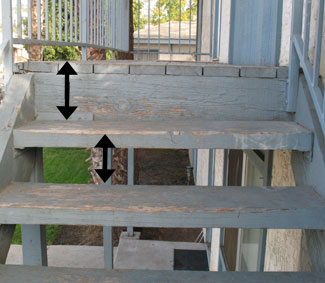Improper Riser Spacing

These are often referred to as riser variations and most building
codes will allow up to 3/8 of an inch, but it is hard to figure out
exactly what they are referring to.
I remember one time, I was
working on a cabin and the owner said they were allowed to cut down one
third of the trees. There were 18 trees on the property and
realistically would be allowed to cut down six trees, but the question
remains that most people don't think about.
After six trees are
cut down, the homeowner would now have 12 trees left and might be
allowed to cut down one third of those trees. After I pointed this out
to him, he was puzzled, but if you think about it, you would probably be
allowed to cut down all of the trees except for the last two and even
that could be questioned.
My point being that what if all of the
risers were 7 inches, except for two, one being 7 1/4 and the other 7
1/2. Would something like this be allowed by the building inspector?
What individual stair riser measurement is going to be used to
determine the 3/8 of an inch variation?
The only thing I could
think of that would make sense, would be if all of the risers were the
same except for one and if this was the case, then that one riser
couldn't be 3/8 of an inch taller or shorter than the others.
This is a tricky building code, but it doesn't take a lot of
construction knowledge to realize that stair variations can create
accidents and this is why it's important to plan out and build the
stairway correctly, with the knowledge of how every material added to
the upper or lower floors and stair treads, will affect each individual
riser.
Now with remodels, it's a completely different story. If
you're going to add 1 inch of additional flooring materials like tile to
the bottom or top floor or landing of the stairway, then you can plan on
creating a riser variation and problems the stairway.
How To Figure And Calculate Stair Risers
Maximum Variation In Stair Risers


